Reforming Forest Policies and Management in Russia: Problems and Challenges
Abstract
1. Introduction
2. History of Problems and Literature Review
3. Introduction of “Intensive Forest Management Model” in Russia
4. Why Is the Intensive Forestry Management Model Good for Timber Industries, Biodiversity and Primary Forests in Russia When Compared with Nordic Countries?
5. Discussion
5.1. How to Promote the Introduction of the Intensive Forestry Management Model in Russia?
5.2. Challenge of “Spatial de-Marginalization” of the Russian Forestry Complex
6. Conclusions
Author Contributions
Funding
Data Availability Statement
Acknowledgments
Conflicts of Interest
Abbreviations
| AAC | Annual allowable cut set by the forest authorities |
| ER | European Russia |
| Goslesfond | Forests that grow on the legal forest land category |
| IURF | Concept of Intensive Use and Regeneration of Forests |
| KPI | Key performance indicators |
| Rosimushchestvo | Federal Agency for State Property Management |
| Roskadastr | Federal Service for State Registration, Cadaster and Cartography |
| Rosleskhos Federal | Forestry Agency under auspices of the Ministry of Natural Resources of the Russian Federation |
| Rosselkhoznadzor | Federal Service for Veterinary and Phytosanitary Supervision under auspices of the Ministry of Agriculture of the Russian Federation |
References
- Mordyushenko, O. Forest from Russia Is Delayed. 2023. Available online: https://www.kommersant.ru/doc/5998286 (accessed on 25 May 2023). (In Russian).
- Angelstam, P.; Naumov, V.; Elbakidze, M. Transitioning from Soviet wood mining to sustainable forest management by intensification: Are tree growth rates different in northwest Russia and Sweden? Forestry 2017, 90, 292–303. [Google Scholar] [CrossRef]
- Dobrynin, D.; Jarlebring, N.Y.; Mustalahti, I.; Sotirov, M.; Kulikova, E.; Lopatin, E. The forest environmental frontier in Russia: Between sustainable forest management discourses and “wood mining” practice. Ambio 2021, 50, 2138–2152. [Google Scholar] [CrossRef] [PubMed]
- Gerasimov, Y.; Senko, S.; Karjalainen, T. Prospects of forest road infrastructure development in northwest Russia with proven Nordic solutions. Scand. J. For. Res. 2013, 28, 758–774. [Google Scholar] [CrossRef]
- Havimo, M.; Mönkönen, P.; Lopatin, E.; Dahlin, B. Optimising forest road planning to maximise the mobilisation of wood biomass resources in Northwest Russia. Biofuels 2017, 8, 501–514. [Google Scholar] [CrossRef]
- Elbakidze, M.; Andersson, K.; Angelstam, P.; Armstrong, G.W.; Axelsson, R.; Doyon, F.; Hermansson, M.; Jacobsson, J.; Pautov, Y. Sustained yield forestry in Sweden and Russia: How does it correspond to sustainable forest management policy? Ambio 2013, 42, 160–173. [Google Scholar] [CrossRef] [PubMed]
- Naumov, V.; Angelstam, P.; Elbakidze, M. Barriers and bridges for intensified wood production in Russia: Insights from the environmental history of a regional logging frontier. For. Policy Econ 2016, 66, 1–10. [Google Scholar] [CrossRef]
- Sidorova, M.; Trifonova, P. Forest is over. For. Ind. 2016, 12, 17–25. [Google Scholar]
- Bartalev, S.A.; Stytsenko, F. Assessment of Forest-Stand Destruction by Fires Based on Remote-Sensing Data on the Seasonal Distribution of Burned Areas. Contemp. Probl. Ecol. 2021, 14, 711–716. [Google Scholar] [CrossRef]
- Shvarts, E.A.; Ptichnikov, A.V. Low-carbon development strategy of Russia and the role of forests in its implementation. Sci. Work. Free Econ. Soc. Russ. 2022, 236, 399–426. (In Russian) [Google Scholar] [CrossRef]
- Kobyakov, K.N.; Shmatkov, N.M.; Shvarts, E.A.; Karpachevsky, M.L. Loss of Intact Forest Landscapes in Russia and Effective Forest Management in Secondary Forests as Its Alternative for Biodiversity Conservation and Sustainable Rural Development. In Proceedings of the XIV World Forestry Congress, Durban, South Africa, 7–11 September 2015. [Google Scholar]
- Leskinen, P.; Lindner, M.; Verkerk, P.J.; Nabuurs, G.-J.; van Brusselen, J.; Kulikova, E.; Hassegawa, M.; Lerink, B. Russian Forests and Climate Change. What Science Can Tell Us; European Forest Institute: Joensuu, Finland, 2020; 136p. [Google Scholar] [CrossRef]
- Shvarts, E.A.; Starikov, I.V.; Kharlamov, V.S.; Golunov, R.Y.; Kobyakov, A.V.; Lukovtsev, F.Y.; Ptichnikov, A.V.; Tyuleneva, O.V.; Shmatkov, N.M.; Shchegolev, A.A.; et al. New look: Proposals for the draft Strategy for the development of the forest complex. Sustain. For. Manag. 2020, 4, 2–25. (In Russian) [Google Scholar]
- Shvarts, E.A.; Yaroshenko, A.Y.; Zamolodchikov, D.G.; Shmatkov, N.M. On the new strategy for development of forest complex in the Russian Federation until 2030. Sustain. For. Manag. 2021, 1, 2–6. (In Russian) [Google Scholar]
- Lambin, E.F.; Gibbs, H.K.; Heilmayr, R.; Carlson, K.M.; Fleck, L.C.; Garrett, R.D.; Le Polain de Waroux, Y.; McDermott, C.L.; McLaughlin, D.; Newton, P.; et al. The role of supply-chain initiatives in reducing deforestation. Nat. Clim. Chang. 2018, 8, 109–116. [Google Scholar] [CrossRef]
- World Bank. Russia: Forest Policy during Transition. 1997. Available online: https://archive.org/details/russiaforestpoli00worl (accessed on 15 October 2022).
- Nilsson, M.; Söderholm, P. Foreign direct investment and institutional obstacles: The case of Russian forestry. Nat. Resour. Forum 2002, 26, 302–313. [Google Scholar] [CrossRef]
- Tysiachniouk, M. Fostering transparency in the transnational supply chain: From Russian forest producers to consumers in Europe and the USA. For. Policy Econ. 2013, 31, 3–11. [Google Scholar] [CrossRef]
- Newell, J.P.; Simeone, J. Russias forests in a global economy: How consumption drives environmental change. Eurasian Geogr. Econ. 2014, 55, 37–70. [Google Scholar] [CrossRef]
- Ulybina, O. Russian forests: The path of reform. For. Policy Econ. 2014, 38, 143–150. [Google Scholar] [CrossRef]
- Malets, O. When Transnational Standards Hit the Ground: Domestic Regulations, Compliance Assessment and Forest Certification in Russia. J. Environ. Policy Plan. 2015, 17, 332–359. [Google Scholar] [CrossRef]
- Petrunin, N.A. Resource and Investment Support of the Russian Forestry Complex in the Context of Economic Sanctions: Presentation for a Speech at the 24th St. Petersburg International Timber Forum, 12 October 2022, St. Petersburg/Nikolay Petrunin. St. Petersburg. 2022. Available online: https://docs.yandex.ru/docs/view?url=ya-disk-public%3A%2F%2Fda8M36cu2BFTP48eqNlYNR39TIeZ0P675B9ydNDjJiDC6adpsSdnb%2Bbe811zbtztq%2FJ6bpmRyOJonT3VoXnDag%3D%3D%3A%2F%D0%9F%D1%80%D0%B5%D0%B7%D0%B5%D0%BD%D1%82%D0%B0%D1%86%D0%B8%D0%B8%2012.10.2022%2F%D0%9B%D0%B5%D1%81%D0%BD%D0%BE%D0%B5%20%D1%85%D0%BE%D0%B7%D1%8F%D0%B9%D1%81%D1%82%D0%B2%D0%BE%2F10.30%20%D0%9D%D0%B8%D0%BA%D0%BE%D0%BB%D0%B0%D0%B9%20%D0%9F%D0%B5%D1%82%D1%80%D1%83%D0%BD%D0%B8%D0%BD.pdf&name=10.30%20%D0%9D%D0%B8%D0%BA%D0%BE%D0%BB%D0%B0%D0%B9%20%D0%9F%D0%B5%D1%82%D1%80%D1%83%D0%BD%D0%B8%D0%BD.pdf&nosw=1) (accessed on 25 October 2022).
- Antonova, N.E. 2021 National Timber Industry Complex: Changes in Spatial Distribution. Regionalistica 2021, 8, 5–20. (In Russian) [Google Scholar] [CrossRef]
- Shvarts, E.A.; Kazantsev, N.N.; Baybar, A.S. Rational use of abandoned agricultural land: One step forward, two steps back. Sustain. For. Manag. 2021, 1, 7–12. (In Russian) [Google Scholar]
- Romanyuk, B.D. Requirements for standards for an economically justified model of forest management. In Intensive Sustainable Forestry: Barriers and Development Prospects; Shmatkov, N., Ed.; World Wildlife Fund (WWF): Moscow, Russia, 2013; pp. 9–20. (In Russian) [Google Scholar]
- The Concept of Intensive Use and Reproduction of Forests FBU “SPbNIILKh”. Saint Petersburg, Russia. 2015. Available online: https://spb-niilh.ru/pdf/Rosleshoz_booklet.pdf (accessed on 15 March 2022). (In Russian).
- Shvarts, E.; Shmatkov, N.M. Myths and problems of forestry reform in Russia. Obs. Nauk. Sovrem. 2020, 3, 35–53. (In Russian) [Google Scholar] [CrossRef]
- Senko, S.; Kurttila, M.; Karjalainen, T. Prospects for Nordic intensive forest management solutions in the Republic of Karelia. Silva Fenn. 2018, 52, 7763. [Google Scholar] [CrossRef]
- Nordberg, M.; Angelstam, P.; Elbakidze, M.; Axelsson, R. From logging frontier towards sustainable forest management: Experiences from boreal regions of North-West Russia and North Sweden. Scand. J. Res. 2013, 28, 797–810. [Google Scholar] [CrossRef]
- Men, M.A.; Morokhoeva, I.P. Report on the Results of the Control Activities “Checking the Efficiency of Forest Resources Use and Budgetary Funds Aimed at the Implementation Authorities of the Russian Federation in the Field of Forest Relations in 2016–2018 and the Past Period of 2019” (Jointly with the Control and Accounting Authorities of the Constituent Entities of the Russian Federation). 2020. Available online: https://ach.gov.ru/upload/iblock/615/615ed6c35deb0be824f57b74225f601c.pdf (accessed on 22 March 2020). (In Russian)
- Ptichnikov, A.; Shvarts, E. Improving state policy in the forestry sector. Lesprominform 2020, 8, 22–25. Available online: https://lesprominform.ru/jarticles.html?id=5824 (accessed on 15 December 2022). (In Russian).
- Shvarts, E.A. The Deeper into the Forest, the Less Export. 2018. Available online: https://www.kommersant.ru/doc/3797639 (accessed on 22 March 2020). (In Russian).
- Shvarts, E.A. Forestry, economic development and biodiversity: Abandon the myths of the past. Sustain. For. Manag. 2003, 2, 2–7. (In Russian) [Google Scholar]
- Shvarts, E.A.; Shmatkov, N.M.; Kobyakov, K.N. Analysis of the state program “Development of forestry for 2013–2020” and recommendations for its improvement. Sustain. For. Manag. 2015, 41, 2–9. (In Russian) [Google Scholar]
- Sokolov, V.A. Problems of sustainable development of the forest complex in Siberia. Lesn. Khozyaystvo 2003, 3, 2–4. (In Russian) [Google Scholar]
- Sokolov, V.A.; Sokolova, N.V.; Vtyurina, O.P.; Lapin, E.A. Forecast of forest dynamics in the Krasnoyarsk Territory. Sib. For. J. 2017, 91–100. (In Russian) [Google Scholar] [CrossRef]
- Chuvasov, E.V. Depletion of Mongolian Oak and Manchurian Ash Timber Resources in Primorsky Krai; World Wide Fund for Nature (WWF): Vladivostok, Russia, 2018; Available online: https://wwf.ru/resources/publications/booklets/istoshchenie-resursov-drevesiny-duba-mongolskogo-i-yasenya-manchzhurskogo-v-primorskom-krae/ (accessed on 25 November 2020). (In Russian)
- Karpachevsky, M.; Aksenov, D.; Esipova, E.; Vladimirova, N.; Danilova, I.; Kobyakov, K.; Zhuravleva, I. Intact forest areas in Russia: Current state and losses over the past 13 years. Sustain. For. Manag. 2015, 2, 2–7. (In Russian) [Google Scholar]
- Kuuluvainen, T.; Lindberg, H.; Vanha-Majamaa, I.; Keto-Tokoi, P.; Punttila, P. Low-level retention forestry, certification, and biodiversity: Case Finland. Ecol. Process 2019, 8, 47. [Google Scholar] [CrossRef]
- Koivula, M.; Vanha-Majamaa, I. Experimental evidence on biodiversity impacts of variable retention forestry, prescribed burning, and deadwood manipulation in Fennoscandia. Ecol. Process 2020, 9, 11. [Google Scholar] [CrossRef]
- Pohjanmies, T.; Eyvindson, K.; Triviño, M.; Bengtsson, J.; Mönkkönen, M. Forest multifunctionality is not resilient to intensive forestry. Eur. J. For. Res. 2021, 140, 537–549. [Google Scholar] [CrossRef]
- Ranius, T.; Hämäläinen, A.; Egnell, G.; Olsson, B.; Eklöf, K.; Stendahl, J.; Rudolphi, J.; Sténs, A.; Felton, A. The effects of logging residue extraction for energy on ecosystem services and biodiversity: A synthesis. J. Environ. Manag. 2018, 209, 409–425. [Google Scholar] [CrossRef]
- Ulybina, O. Model Forests in the Russian Federation: Local Perspectives, Challenges and Outcomes. Environ. Policy Gov. 2015, 25, 474–485. [Google Scholar] [CrossRef]
- Angelstam, P.; Elbakidze, M.; Axelsson, R.; Khoroshev, A.; Pedroli, B.; Tysiachniouk, M.; Zabubenin, E. Model forests in Russia as landscape approach: Demonstration projects or initiatives for learning towards sustainable forest management? For. Policy Econ. 2019, 101, 96–110. [Google Scholar] [CrossRef]
- Koroleva, T.S.; Yakusheva, T.V. Investigation the Practice of the Forestry Innovation in the Russian Federation; Saint Petersburg Forestry Research Institute: Saint Petersburg, Russia, 2020; p. 3. (In Russian) [Google Scholar] [CrossRef]
- Knize, A.; Romanyuk, B. About two points of view on the Russian forest and forestry. Sustain. For. Manag. 2004, 3, 2–7. (In Russian) [Google Scholar]
- Knize, A.; Romanyuk, B. About two points of view on the Russian forest and forestry. Sustain. For. Manag. 2004, 4, 21–28. (In Russian) [Google Scholar]
- Trishkin, M.; Lopatin, E.; Shmatkov, N.; Karjalainen, T. Assessment of sustainability of forest management practices on the operational level in northwestern Russia—A case study from the Republic of Karelia. Scand. J. For. Res. 2017, 32, 620–632. [Google Scholar] [CrossRef]
- Hartmann, H.; Daoust, G.; Bigué, B.; Messier, C. Negative or positive effects of plantation and intensive forestry on biodiversity: A matter of scale and perspective. For. Chron. 2010, 86, 354–364. [Google Scholar] [CrossRef]
- Gauthier, S.; Kuuluvainen, T.; Macdonald, S.E.; Shorohova, E.; Shvidenko, A.; Bélilse, A.-C.; Vaillancourt, M.-A.; Leduc, A.; Grosbois, G.; Bergeron, Y.; et al. Ecosystem management of the boreal forest in the era of global change. In Boreal Forests in the Face of Climate Change; Springer: Berlin/Heidelberg, Germany, 2023. [Google Scholar] [CrossRef]
- Gustafsson, L.; Bauhus, J.; Asbeck, T.; Augustynczik, A.L.D.; Basile, M.; Frey, J.; Gutzat, F.; Hanewinkel, M.; Helbach, J.; Jonker, M.; et al. Retention as an integrated biodiversity conservation approach for continuous-cover forestry in Europe. Ambio 2020, 49, 85–97. [Google Scholar] [CrossRef]
- Shorohova, E.; Sinkevich, S.; Kryshen, A.; Vanha-Majamaa, I. Variable retention forestry in European boreal forests in Russia. Ecol. Process 2019, 8, 34. [Google Scholar] [CrossRef]
- Kotel’nikov, R.V.; Lupyan, E.A.; Bartalev, S.A.; Ershov, D.V. Space Monitoring of Forest Fires: History of the Creation and Development of ISDM-Rosleskhoz. Contemp. Probl. Ecol. 2020, 13, 795–802. (In Russian) [Google Scholar] [CrossRef]
- Kovalev, N.A.; Loupian, E.A.; Balashov, I.V.; Bartalev, S.A.; Burtsev, M.A.; Ershov, D.V.; Krivosheev, N.P.; Mazurov, A.A. ISDM-Rosleskhoz: 15 years of operation and evolution. Sovrem. Probl. Distantsionnogo Zondirovaniya Zemli Kosmosa 2020, 17, 283–291. (In Russian) [Google Scholar] [CrossRef]
- Pisarenko, A.I.; Strakhov, V.V. Forestry in Russia: From Use to Management; Jurisprudence: Moscow, Russia, 2004. (In Russian) [Google Scholar]
- Shvidenko, A.Z.; Schepashchenko, D.G.; Nilsson, S.; Buluy, Y.I. Tables and Models of Growth and Productivity of Forests of Major Forest Forming Species of Northern Eurasia (Standard and Reference Materials); Federal Forestry Agency: Moscow, Russia, 2008. (In Russian) [Google Scholar]
- Kirilenko, A.; Dronin, N. Recent grain production boom in Russia in historical context. Clim. Change 2022, 171, 22. [Google Scholar] [CrossRef]
- State (National) Report on the State and Use of the Lands of the Russian Federation in 2019, 2020, n.d. Moscow, Russia. Available online: https://rosreestr.gov.ru/site/activity/gosudarstvennyy-natsionalnyydoklad-o-sostoyanii-i-ispolzovanii-zemel-rossiyskoy-federatsii/ (accessed on 15 March 2021). (In Russian)
- Griscom, B.W.; Adams, J.; Ellis, P.W.; Houghton, R.A.; Lomax, G.; Miteva, D.A.; Schlesinger, W.H.; Shoch, D.; Siikamäki, J.V.; Smith, P.; et al. Natural climate solutions. Proc. Natl. Acad. Sci. USA 2017, 114, 11645–11650. [Google Scholar] [CrossRef]
- Moreau, L.; Thiffault, E.; Cyr, D.; Boulanger, Y.; Beauregard, R. How can the forest sector mitigate climate change in a changing climate? Case studies of boreal and northern temperate forests in eastern Canada. For. Ecosyst. 2022, 9, 100026. [Google Scholar] [CrossRef]
- Averkieva, K.V. Symbiosis of agriculture and forestry on the early-developed periphery of the non-black earth region: The case of the Tarnogsky district of the Vologda region. Russ. Peasant Stud. 2017, 2, 86–106. (In Russian) [Google Scholar] [CrossRef]
- Lesiv, M.; Schepaschenko, D.; Moltchanova, E.; Bun, R.; Durauer, M.; Prishchepov, A.; Schierhorn, F.; Estel, S.; Kuemmerle, T.; Alcantara, C.; et al. Spatial distribution of arable and abandoned land across former Soviet Union countries. Sci. Data 2018, 5, 180056. [Google Scholar] [CrossRef]
- Medvedev, A.A.; Telnova, N.O.; Kudikov, A.V. Remote highly detailed monitoring of the dynamics of overgrowing of abandoned agricultural lands with forest vegetation. Vopr. Lesn. Nauki 2019, 2, 1–12. [Google Scholar] [CrossRef]
- Medvedev, A.A. The Fields and Farms of Central Russia as Seen from Space. Reg. Res. Russ. 2022, 12, S65–S73. [Google Scholar] [CrossRef]
- Dobrynin, D. Management of state forests in Finland and Sweden. Sustain. For. Manag. 2019, 12, 14–17. (In Russian) [Google Scholar]
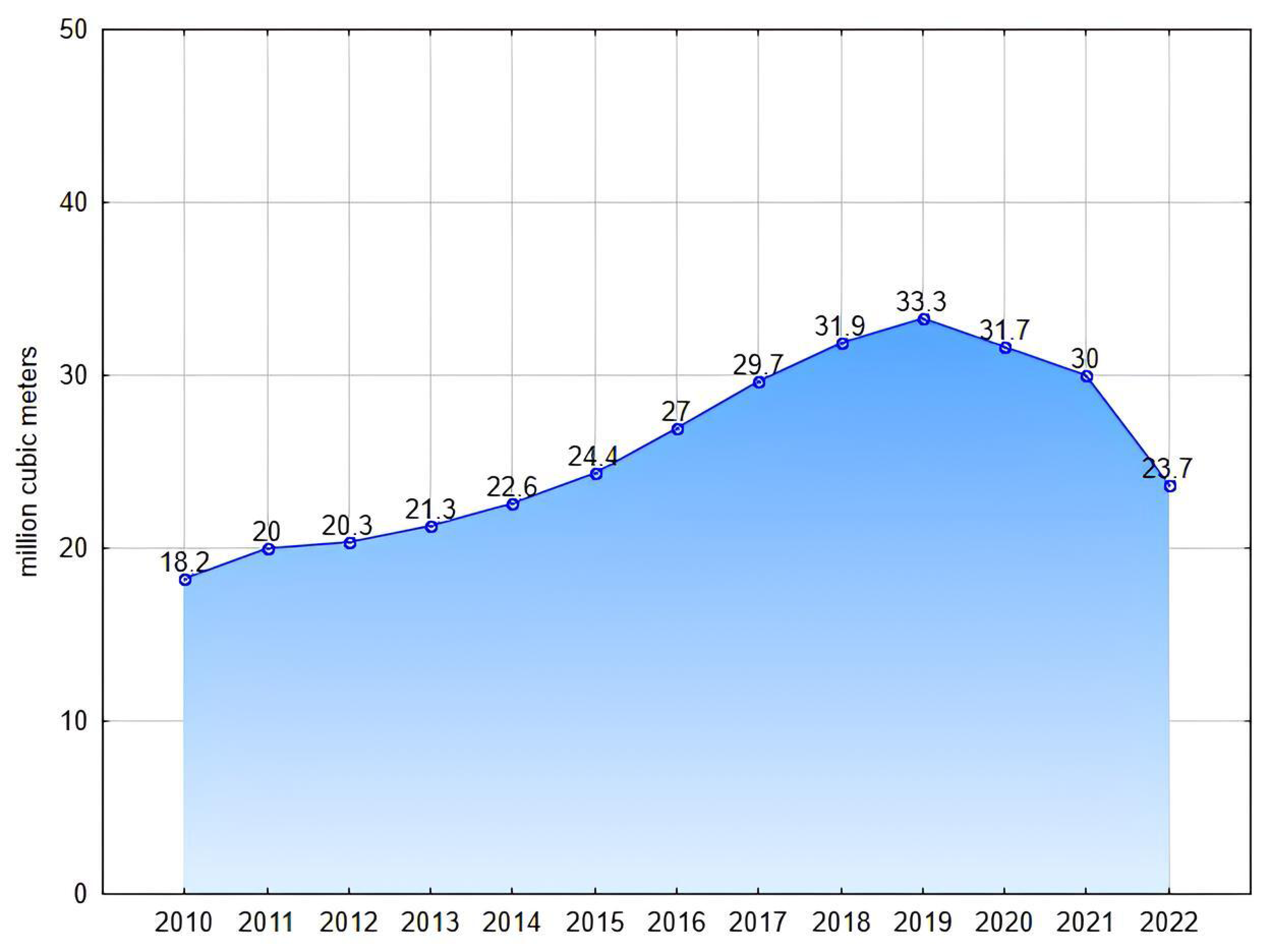
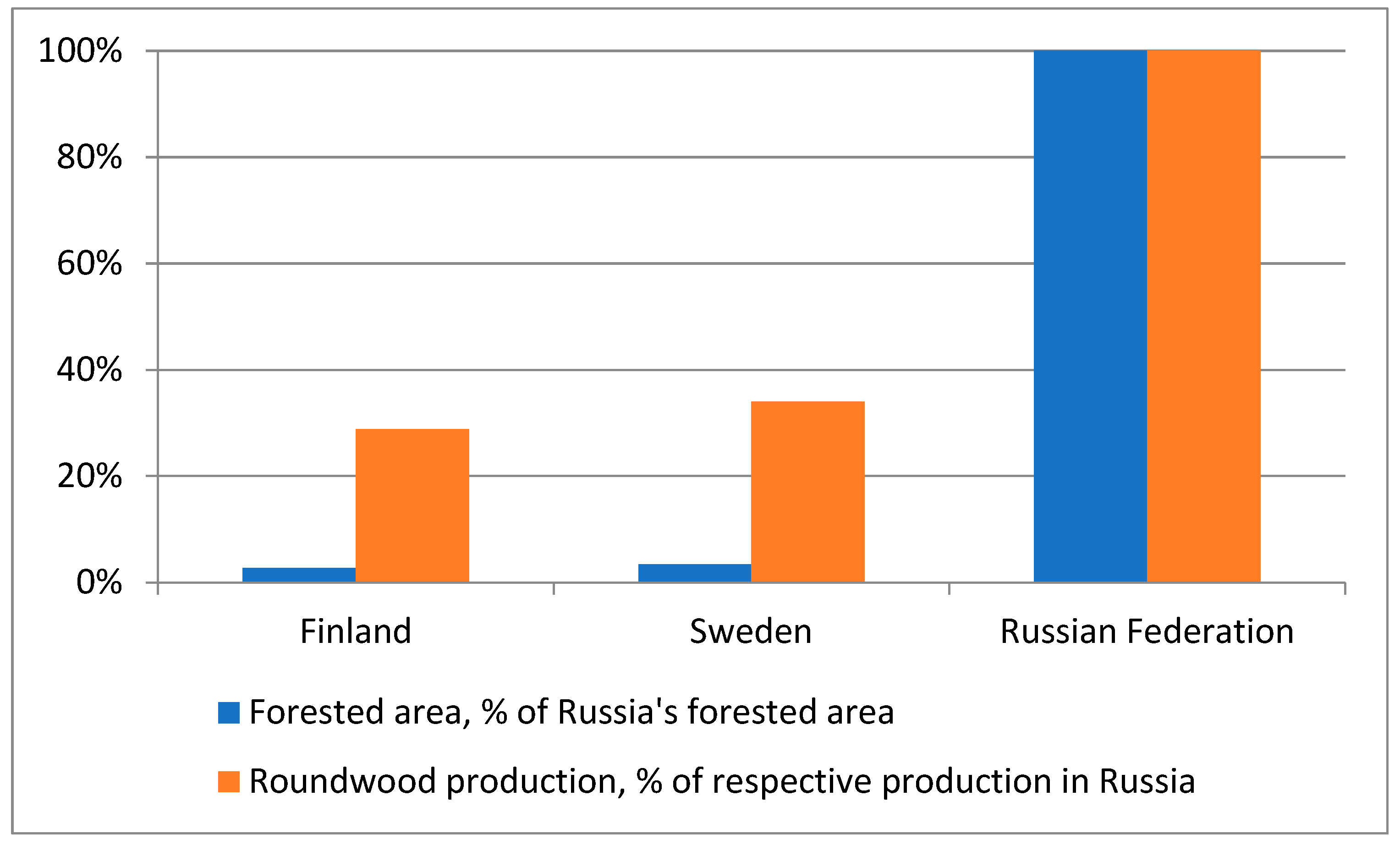
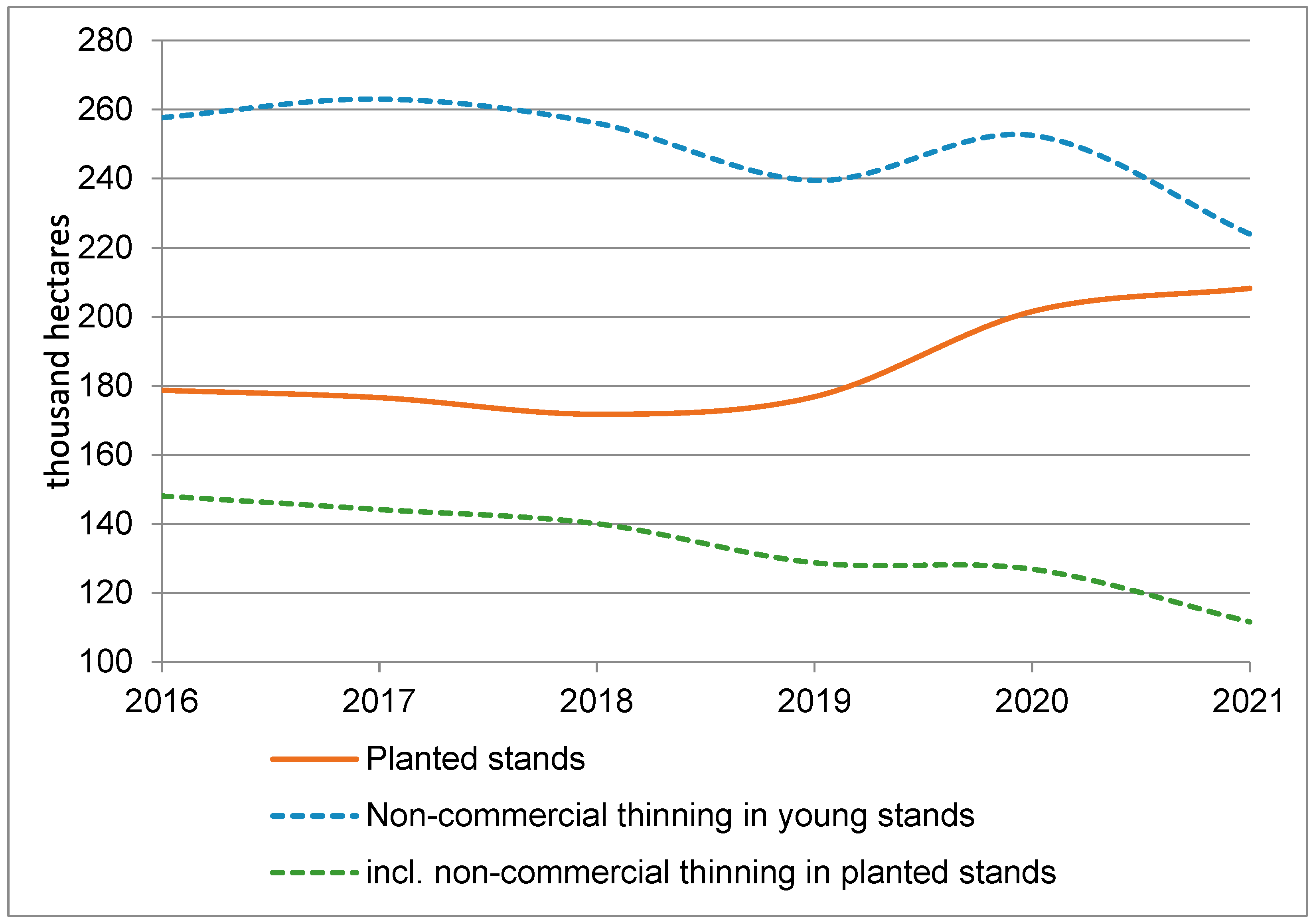
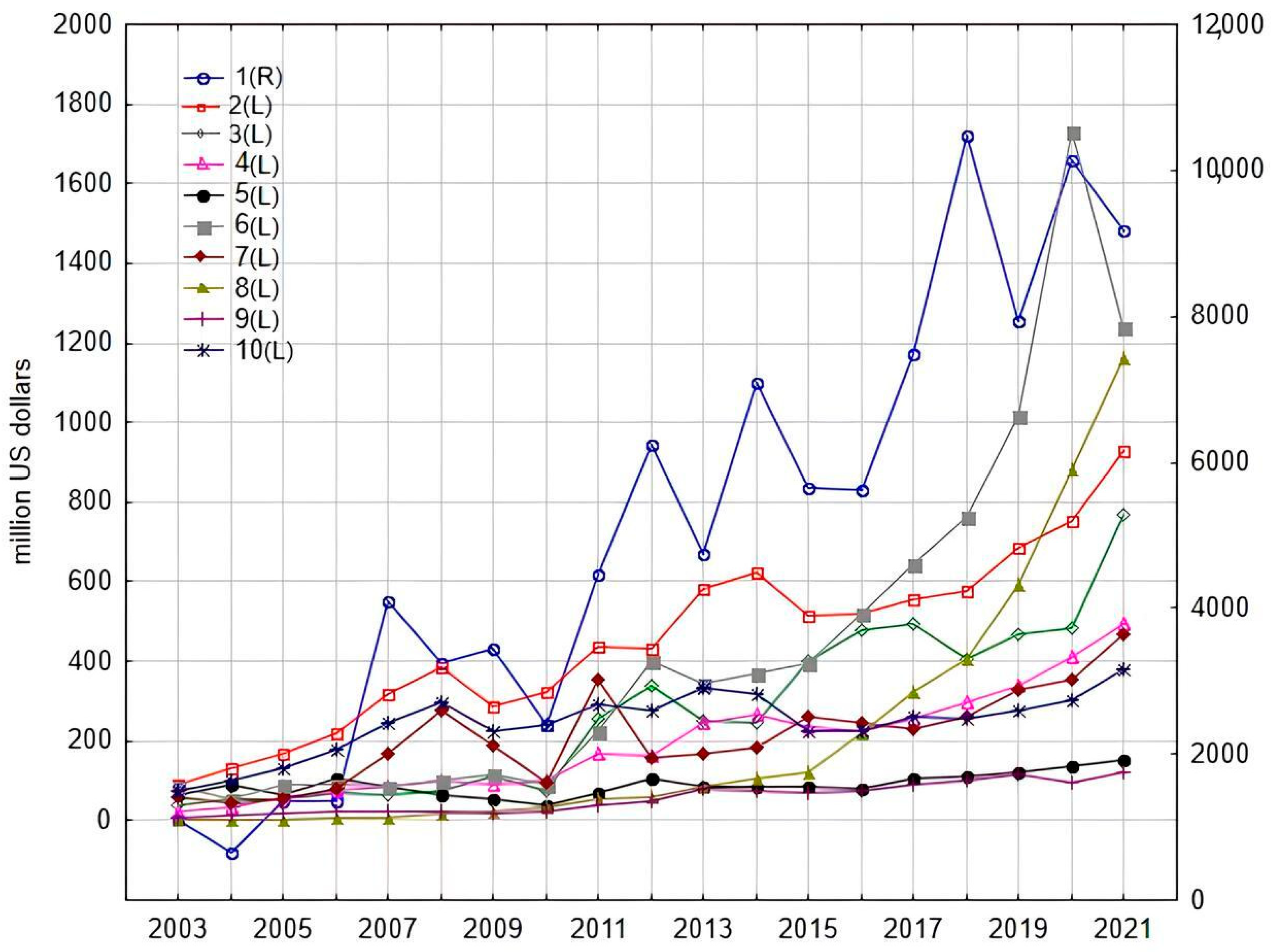
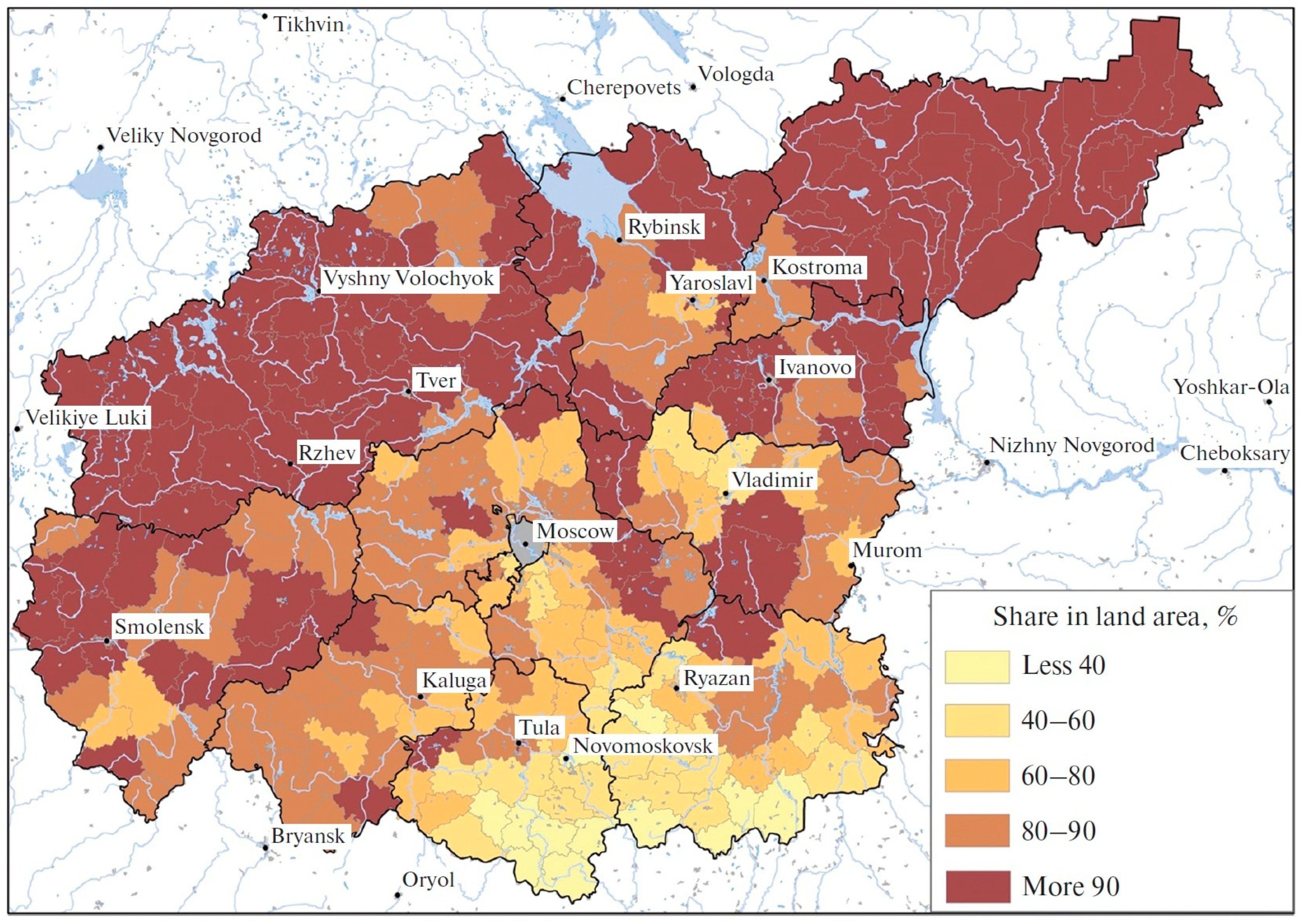
| Top 10 Forest Corporations | Macroregions | Major Sources of Resources | Revenues, Billions of Russian Rubles | Changes 2021/2020 |
|---|---|---|---|---|
| Ilim Group | Nationwide company with a strong presence in Northwestern European Russia and Middle Siberia | Primarily coniferous wood | 180.3 | +46% |
| Segezha Group | Nationwide company with a strong presence in Northwestern European Russia and Middle Siberia | Primarily coniferous wood | 92.4 | +34% |
| Arkhangelsk Pulp and Paper Mill | Northwestern European Russia | Primarily coniferous wood | 72.1 | +71% |
| Mondi Syktyvkar | Northwestern European Russia | Primarily coniferous wood | 71.4 | +17% |
| Kronospan | Central and Southern European Russia | Primarily wood from secondary forests | 60.7 | +37% |
| Sveza | Northwestern European Russia | Primarily coniferous wood | 57.1 | +59% |
| SFT Group | European Russia, including South | Waste paper and secondary cellulose | 36.2 | +75% |
| Egger | Western and Central European Russia | Primarily wood from secondary forests | 35.5 | +38% |
| ULK Group (Ustianskiy Timber Complex) | Northwestern European Russia (Arkhangelsk region) | Primarily coniferous wood | 34.0 | +63% |
| Company group Vologodskiye lesopromyshlenniki, VLP | Northwestern European Russia | Primarily coniferous wood | 30.0 | +64% |
| Country | Share of Artificial Regeneration Area from the Clearcut Area, % | Share of Non-Commercial Thinning in Young Forests Area from the Artificial Regeneration Area, % | The Total Harvest Volume (m3) per Hectare of Clearcut Area ** |
|---|---|---|---|
| Russia (2021) *** | 17% | 108% * | 184 |
| Finland (average for 2016–2020) | 72% | 140% | 455 |
| Sweden (average 2016–2020) | 77% | 246% | 313 |
Disclaimer/Publisher’s Note: The statements, opinions and data contained in all publications are solely those of the individual author(s) and contributor(s) and not of MDPI and/or the editor(s). MDPI and/or the editor(s) disclaim responsibility for any injury to people or property resulting from any ideas, methods, instructions or products referred to in the content. |
© 2023 by the authors. Licensee MDPI, Basel, Switzerland. This article is an open access article distributed under the terms and conditions of the Creative Commons Attribution (CC BY) license (https://creativecommons.org/licenses/by/4.0/).
Share and Cite
Shvarts, E.A.; Karpachevskiy, M.L.; Shmatkov, N.M.; Baybar, A.S. Reforming Forest Policies and Management in Russia: Problems and Challenges. Forests 2023, 14, 1524. https://doi.org/10.3390/f14081524
Shvarts EA, Karpachevskiy ML, Shmatkov NM, Baybar AS. Reforming Forest Policies and Management in Russia: Problems and Challenges. Forests. 2023; 14(8):1524. https://doi.org/10.3390/f14081524
Chicago/Turabian StyleShvarts, Evgeny A., Mikhail L. Karpachevskiy, Nikolay M. Shmatkov, and Anastasia S. Baybar. 2023. "Reforming Forest Policies and Management in Russia: Problems and Challenges" Forests 14, no. 8: 1524. https://doi.org/10.3390/f14081524
APA StyleShvarts, E. A., Karpachevskiy, M. L., Shmatkov, N. M., & Baybar, A. S. (2023). Reforming Forest Policies and Management in Russia: Problems and Challenges. Forests, 14(8), 1524. https://doi.org/10.3390/f14081524







